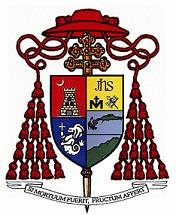

What is a Pastoral Visitation? Every 5 years, the local Ordinary (bishop or archbishop) is directed by the laws of the Church to embark on a pastoral visitation of parishes and church institutions. The purpose is to strengthen these communities of faith and to draw out the spiritual energies of the church for the mission of evangelization. Evangelization is the “raison d’etre” of the church: it exists in order to evangelize.
“A bishop is obliged to visit the diocese annually, either in whole or in part, so that he visits the entire diocese at least every five years either personally or, if he has been legitimately impeded, through the coadjutor Bishop, an auxiliary Vicar general, Episcopal Vicar, or another presbyter.” (Code of Canon Law, c. 396)
“The pastoral visit is therefore an apostolic activity to be carried out by the Bishop in true pastoral activity, which reveals him to be the principle and visible foundations if the unity of the particular church. For the communities or institutions visited by the Bishop, it is an event of grace, reflecting in some measure that great visit with which the “chief shepherd” (1 Peter 5:4) and Guardian of our souls (1 Peter 2:25), Jesus Christ, has visited and redeemed his people (Luke 1:68)
The Archbishop of Manila, His Eminence Gaudencio Cardinal Rosales,DD, is the real shepherd of the parish. Since the Archdiocese has more than 80 parishes and shrines, the Cardinal appoints Parish Priests to shepherd for him. His pastroal visit is an occasion to rejuvenate the energies of those engaged in evangelization, to praise, encourage and reassure them. It is also an opportunity to invite the faithful to a renewal of Christian life and to an ever more intense apostolic activity. The pastoral visit helps the Bishop to evaluate the effectiveness of the structures and agencies designed for pastoral service, taking account of the circumstances and difficulties of the task of evangelization, so as to determine more accurately the priorities and the means required for overall pastoral provision.
The following are the objectives of the pastoral visit:
1. “In the spirit of Communio”: to strengthen the bonds if communion among the people of the Archdiocese of Manila and the Cardinal Archbishop as the visible sign of unity. The apostolic vision is the binding force of communion among the members of the Church in Manila.
2. “In a state of Mission”: to identify the “best features” and “areas of improvement” of a parish/school/community. The following domains to be presented are: catechesis, liturgy and popular religiosity, social services and development of the poor, family life and youth, ecumenical and inter-religious affairs, ecology, financial/logistical and organizational culture and climate.
3. “In the service of the Pondo ng Pinoy Movement: the level of commitment of the community in the catechesis and collection of the “crumbs.”
Let us pray for the success of the first ever Pastoral Visitation in our parish. Let this occasion be a source of blessing and communio for all of us.






